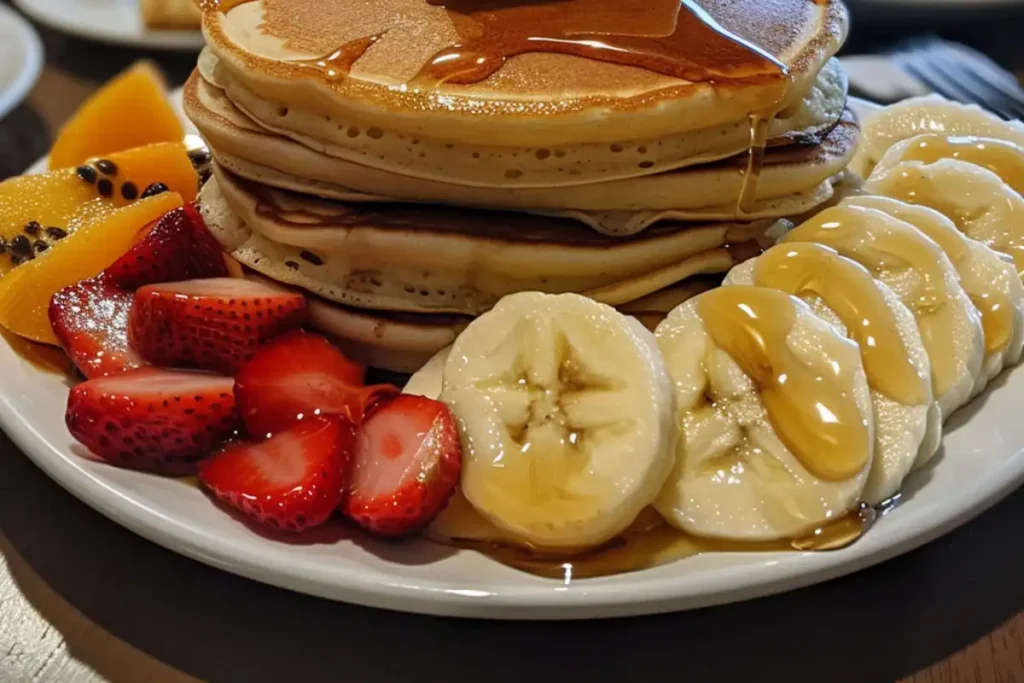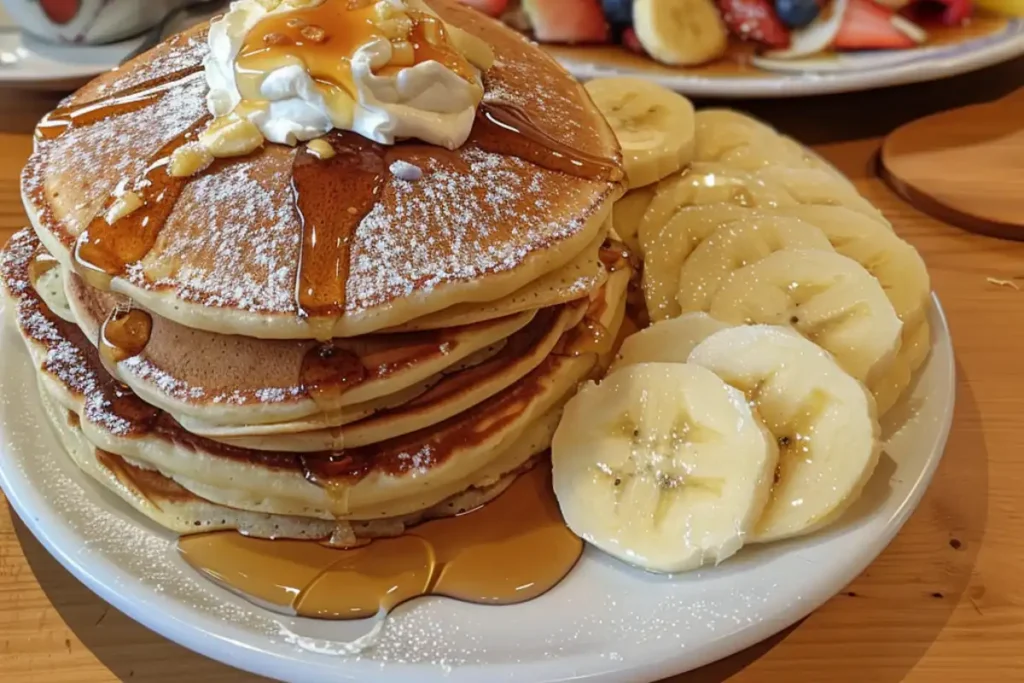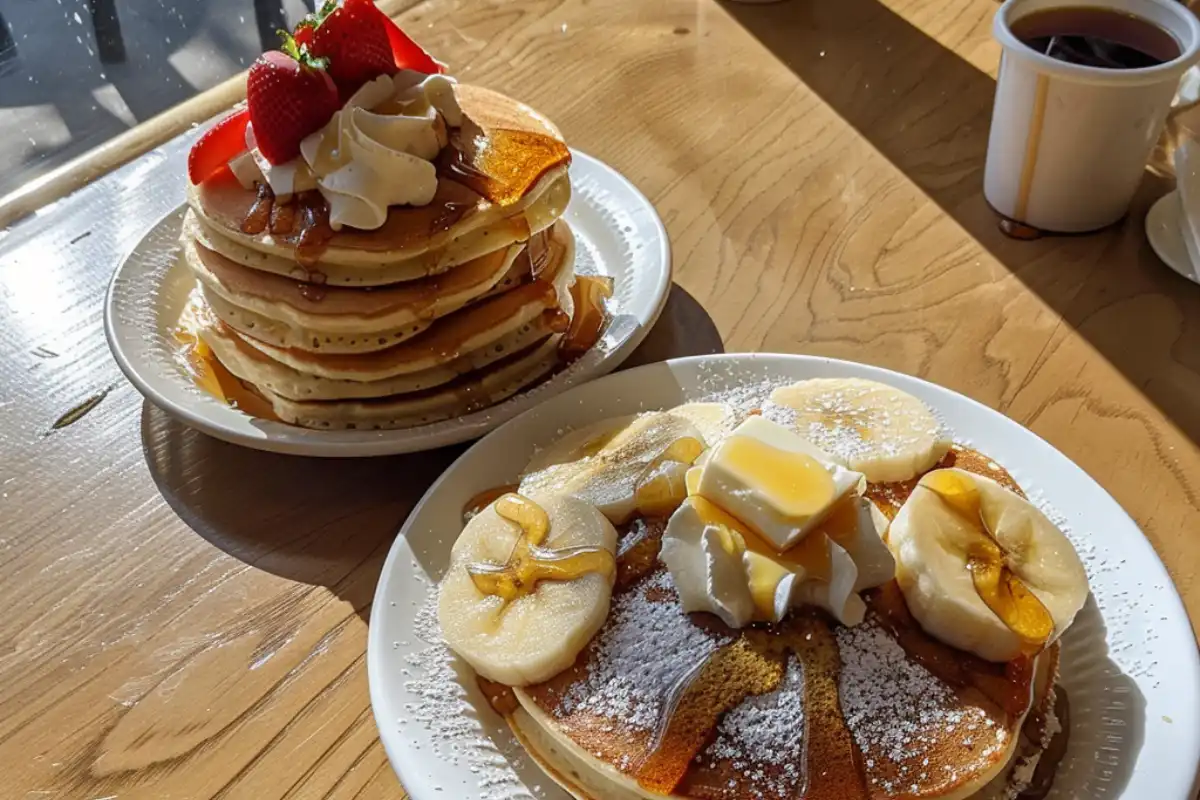Both pancakes and hotcakes are beloved breakfast staples worldwide. While many use the terms interchangeably, there are subtle differences between the two that distinguish them. Whether you’re enjoying a fluffy stack of pancakes or a heartier plate of hotcakes, knowing the difference can help you better appreciate these dishes. So, what sets hotcakes apart from pancakes?
In this article, we will explore the definitions, regional uses, differences in texture, and the cultural history behind both pancakes and hotcakes. Let’s dig into what makes these breakfast dishes similar yet distinct, and discover why one may be better suited for your taste preferences or dietary needs than the other.
To explore more breakfast options, check out Sourdough Banana Muffins: A Healthy Baking Option for a nutritious morning treat to complement your pancakes or hotcakes.
What Are Pancakes?
Pancakes offer a simple, yet versatile breakfast option that uses a batter consisting of flour, eggs, milk, and a leavening agent like baking powder or baking soda. You pour the batter onto a griddle or skillet and cook it until both sides turn golden brown.
Pancakes are a common feature in North American breakfasts, typically served with butter, syrup, fruit, or even whipped cream. Their simplicity and versatility have led to different cultural variations across the world. In France, they are known as crepes, thin and delicate, often filled with sweet or savory ingredients. In the Netherlands, Dutch pannenkoeken are larger and flatter, often topped with a combination of sweet or savory items.
One of the best aspects of pancakes is how adaptable they are. Whether you’re making vegan pancakes or gluten-free pancakes, the basic principles remain the same, and you can experiment with a wide range of toppings and fillings.

If you’re looking to perfect the fluffiness of your pancakes, explore Why Are Restaurant Pancakes So Fluffy? to learn how to achieve restaurant-quality results at home.
What Are Hotcakes?
Hotcakes offer a heartier, denser alternative to pancakes. Both use similar ingredients—flour, eggs, milk, and leavening agents—but hotcakes usually have a thicker batter, which creates a denser texture. In certain regions of the United States, particularly in the South, people more commonly use the term “hotcakes,” often associating it with rustic, traditional breakfasts.
Hotcakes are closely tied to fast-food breakfast menus, where “hotcakes” serve as a signature breakfast item. According to McDonald’s Hotcakes Nutrition, their version is thicker and denser than typical pancakes, contributing to their lasting popularity on the menu.
During early American history, settlers and pioneers frequently ate hotcakes because they required only simple, staple ingredients like flour, cornmeal, and water, which cooks could easily prepare over an open fire. Today, diners and fast-food restaurants continue to serve hotcakes, preserving their nostalgic and hearty appeal.
Key Differences Between Pancakes and Hotcakes
Although pancakes and hotcakes share similar ingredients and preparation methods, there are distinct differences between the two. Here’s how they compare:
1. Regional Terminology
The most obvious difference between pancakes and hotcakes is in the terminology. In the U.S., people more commonly use the term “pancakes,” which appears on menus at diners, restaurants, and in home kitchens across the country. However, in certain regions, particularly the Southern U.S., “hotcakes” is the preferred term, referring to the same general dish with slight variations in texture.
Fast-food chains like McDonald’s have helped popularize the term “hotcakes,” making it synonymous with their version of thick, hearty pancakes. Interestingly, the regional use of the term extends beyond the South. For example, in Canada, the term “hotcakes” is sometimes used interchangeably with pancakes, though “pancakes” is still more widely recognized.
2. Ingredients and Batter Consistency
The ingredients in both pancakes and hotcakes are fairly similar—flour, eggs, milk, and a leavening agent such as baking powder. However, the batter consistency tends to differ:
- Pancakes: Pancake batter is typically thinner, allowing the pancakes to spread out and cook quickly on a hot griddle or skillet. This results in a light, fluffy texture.
- Hotcakes: Hotcake batter is often thicker, which leads to a denser, more substantial cake. Some recipes for hotcakes include less milk or even use cornmeal to create a more rustic texture. Hotcakes are usually cooked at a lower temperature to ensure the inside is fully cooked without burning the exterior.
This difference in batter consistency explains why people often view hotcakes as a heartier, more filling breakfast option.
3. Cooking Method and Texture
Cooking methods significantly affect the texture of pancakes and hotcakes. Cooks typically prepare pancakes at a high temperature, which quickly browns the outside while keeping the inside soft and airy. This fast cooking process produces light, fluffy pancakes with a tender crumb.
Hotcakes, on the other hand, are cooked at a lower temperature for a longer period. This slower cooking process allows the inside to cook through while developing a crisp, golden-brown exterior. The end result is a hotcake that is denser and chewier than a traditional pancake.
To explore different pancake textures, try this Fluffy Pancake cake Recipe, which showcases how varying ingredients and cooking techniques can affect the final product.
4. Thickness and Density
Another notable difference between pancakes and hotcakes is their thickness and density. Pancakes are typically thinner, often around ¼ to ½ inch thick, while hotcakes are usually thicker and denser, sometimes over an inch in height. The thick texture of hotcakes creates a heartier feel, making them a filling breakfast option that pairs well with simple toppings like butter and syrup.
In contrast, people often top pancakes with a variety of ingredients, such as fruit, whipped cream, chocolate chips, and powdered sugar, making them a more versatile dish in both flavor and presentation.
Historical Background and Cultural Significance
Origins of Pancakes
Pancakes boast a long and storied history, dating back to ancient civilizations. Archaeological evidence reveals that the ancient Greeks and Romans consumed pancakes, making them from a batter of flour, eggs, and milk. These early pancakes were typically thin and crisp, resembling modern-day crepes more than the fluffy pancakes we enjoy today.
Pancakes remain a staple in various cultures worldwide, with each region adding its own spin to the dish. In France, people enjoy crepes, paper-thin pancakes often filled with sweet or savory ingredients. In Japan, they prepare okonomiyaki, a savory pancake made with cabbage, meat, and various toppings. The adaptability of pancakes across cultures explains why they have endured as a beloved breakfast food for centuries.
To learn more about the history of this classic dish, check out the History of Pancakes.
Popularity of Hotcakes in North America
Hotcakes have a long history in North America, where they were a staple in the diets of early settlers and pioneers. Made with simple ingredients like flour, cornmeal, and water, hotcakes were easy to prepare and provided a filling meal for those traveling long distances or working in the fields. Cooked over an open fire on a cast-iron griddle, hotcakes became a symbol of rustic, frontier cooking.
Today, hotcakes are still popular in traditional diners and fast-food restaurants, where they are often served as part of a hearty breakfast. The term “hotcakes” has also become synonymous with fast-food breakfast menus, where their signature hotcakes are a mainstay.

For those who love a classic American breakfast, hotcakes offer a comforting, nostalgic option that harkens back to simpler times.
Nutritional Differences and Variations
Calories and Nutritional Value
When comparing the nutritional content of pancakes and hotcakes, both dishes can vary significantly depending on their size, ingredients, and toppings. On average, pancakes tend to be lighter in calories than hotcakes due to their thinner batter and fluffier texture.
Healthier Variations
For those looking to make healthier versions of pancakes or hotcakes, there are plenty of options available:
- Whole Wheat Pancakes: Substituting whole wheat flour for white flour adds fiber and nutrients, making the dish more nutritious.
- Gluten-Free Pancakes: Using gluten-free flour or other alternatives makes pancakes accessible for those with gluten sensitivities.Check out this Gluten-Free Pancake Recipe for a step-by-step guide to making gluten-free pancakes that don’t compromise on taste or texture.
- Low-Sugar Toppings: Instead of syrup, try topping pancakes or hotcakes with fresh fruit, Greek yogurt, or a drizzle of honey for a healthier option.
For more ideas on nutritious breakfast options, explore the Sourdough Banana Muffins recipe, which can complement your breakfast spread.
Where You’ll Find Pancakes vs. Hotcakes
Pancakes
Pancakes are a breakfast staple in homes, diners, and brunch spots worldwide. Whether you’re visiting a trendy cafe or a traditional diner, pancakes are often served with a variety of toppings like syrup, butter, and fruit.
In the U.S., pancakes are a classic brunch item, often paired with bacon, sausage, or eggs for a complete meal. Pancakes are also popular in international cuisines—French crepes, Dutch pannenkoeken, and Japanese soufflé pancakes each offer unique takes on the traditional pancake.
Hotcakes
In contrast, people often associate hotcakes with fast food and traditional American diners. Restaurants typically serve hotcakes with butter, syrup, and sometimes sausage or bacon on the side, making them a filling breakfast option.
Hotcakes may not be as common in home kitchens as pancakes. However, they remain a nostalgic and comforting dish for many.
Common Misconceptions
Are Pancakes and Hotcakes the Same Thing?
- While the terms are often used interchangeably, there are subtle differences between pancakes and hotcakes. Pancakes tend to be lighter and fluffier, while hotcakes are thicker and denser. These differences are largely due to variations in the batter consistency and cooking method.
Are Hotcakes Healthier?
- Neither dish offers inherent health advantages over the other. However, people often perceive hotcakes as more filling because of their denser texture. You can make both dishes healthier by using whole grain flour and reducing the sugar content. Additionally, choose healthier toppings like fresh fruit or yogurt.
FAQs About Hotcakes and Pancakes
1. Are Hotcakes Thicker Than Pancakes?
- Yes, hotcakes are typically thicker and denser than pancakes. This is due to the thicker batter and longer cooking time required to fully cook the inside without burning the outside.
2. Can You Use the Same Batter for Pancakes and Hotcakes?
- In most cases, yes, you can use the same batter for both pancakes and hotcakes. However, the thickness of the batter and the cooking method may vary to achieve the desired texture for each dish.
3. Are Hotcakes More Filling Than Pancakes?
- Due to their denser texture, hotcakes are often considered more filling than pancakes. This makes them a popular option for those looking for a more substantial breakfast.
Conclusion
While pancakes and hotcakes share many similarities, subtle differences in texture, cooking style, and regional terminology set them apart. Pancakes are known for their light, fluffy texture, while hotcakes offer a heartier, more filling option. Whether you’re a fan of airy pancakes or prefer the denser bite of a hotcake, both dishes offer a delicious way to start the day.
For more breakfast inspiration, explore Sourdough Banana Muffins to add another healthy and delicious recipe to your breakfast routine.

